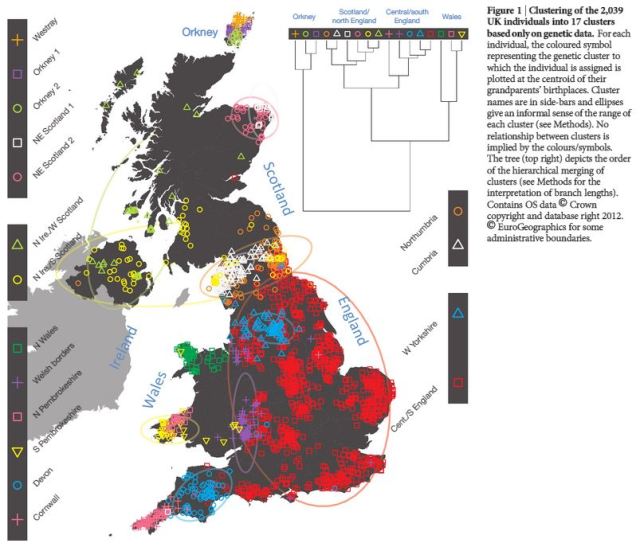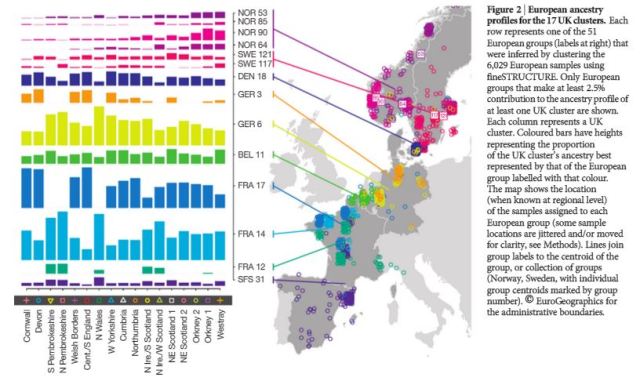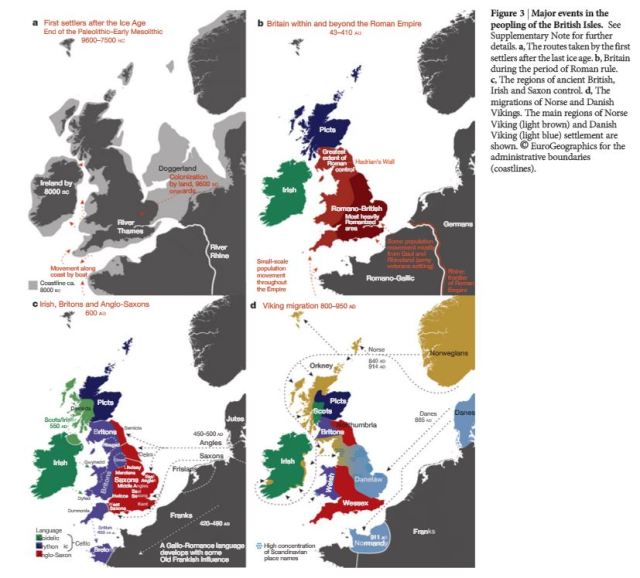The People of the British Isles Project is important and interesting, but in case you haven’t heard about it let me summarise. As the website states “The project has two purposes, the first to help medical research, and the second to shed light on ancient migrations within the British Isles.” On 19th March 2015 Nature Magazine published a peer-reviewed paper from the POBI Project. You can read the full article here. I was also fortunate to attend a lecture given by one of the authors of the paper, Garrett Hellenthal, who worked on the statistical analysis of the data. Hopefully this lecture will appear on YouTube. When it does I’ll post a link.
There has been quite a bit already written about it, so in this blog I just wanted to summarise some of the details from a genetic and historical perspective.
Methodology
- The project took 2039 blood samples from British volunteers.
- Each volunteer was required to have all 4 grand-parents born within 80 km /50 miles of each other.
- The mean point of the 4 births was taken as the “genetic location” of the individual.
- Given that each persons DNA is a guaranteed mixture of their 4 grandparents the study was effectively looking at the make up of the British population c.1885 (the average birth date of the volunteers’ grandparents’ birth dates.
- This methodology was assumed to mean that the testers were “native” of the region. (as an aside I’ve tested this theory on my own ancestors. In all cases when the four great-grandparents of an individual “qualify” as local to a region there were no “migratory” ancestors messing things up.
- The project samples c.520,000 SNPs on each individual.
- Only Autosomal DNA (i.e. not yDNA and mtDNA) was used for the testing.
- The samples were broken down into 17 clusters based on genetic similarities.
- The individuals were then compared to a data-set of 6209 European individuals to identify the European origin of the various clusters.
- The European dataset was taken from samples obtained by hospitals across Europe that were involved in a major study of Multiple Sclerosis.
- Ireland was deliberately excluded from the “European ancestry” analysis by the team as it was impossible to differentiate between the genetic flow to and from Ireland i.e. Would a match with a Irish genetic profile represent the immigration of English/Scots/ Welsh peoples into Ireland, rather than Irish immigration into the rest of the British Isles.
Headline Results
- The genetic clusters (which were generated without knowledge of the location of the individual) clearly correspond to geographic locations.
- When separating out the clusters, based on their genetic variance, the most separate clusters were (in order) the Orkneys, the Welsh, North Wales from South Wales and then the Scots/Northern English/Northern Irish from the Southern English and next the Cornish.
- There is no single celtic-fringe genetic profile representing those in non-Saxon Britain.
- The map below shows both the 17 clusters and a diagram of how the clusters differentiate from each other.

The POBI samples in 17 clusters, based on their genetic similarity. The diagram, top right, shows how the clusters break out from each other.
- There is a relatively homogeneous population within Central and Southern England. This suggested relatively free movement of people within this area.
- The European samples were separated into 51 clusters using the same techniques as with the British samples. Of these only 10 clusters (assuming the Norwegian profiles are grouped as one) were significantly represented among the British population. A breakdown of the “European ancestry” of the 17 UK clusters was provided in the report. This is shown in the diagrams below.
- The paper suggests that European regions that contributed to all UK clusters represent the earlier migrations to Britain, and these groups are shown in the genetic profiles GER6, BEL11, FRA14.
- FRA17 contributes to all the 17 UK clusters, apart from the Welsh groups and suggests a later migration than above.
Historical Interpretation
This is mostly based on the POBI newsletter on the discoveries. As a refresher it’s worth reminding ourselves of the major historical events associated with the population changes within the British Isles. The POBI provided a handy image.
- Looking at the genetic profile of the the British it can overall be viewed as coming from the original post Ice-Age settlers, the Celts, the Anglo-Saxons and in some parts Norse Viking.
- The paper suggests “we see no clear genetic evidence of the Danish Viking occupation and control of a large part of England”
- The genetic variance of the Orkneys reflects their long period as a Norse Viking Earldom from 875 to 1472.
- As reported in the POBI newsletter the separation of North Wales from South Wales probably reflect “the ancient kingdoms of Gwynedd (independent from the end of the Roman period to the 13th century) in the north and Dyfed in the south.”
- The clustering seen in Northern England could be interpreted as showing the pre-Saxon kingdoms of Rheged, Elmet and Bernicia.
- As the POBI newsletter states “The split in the Northern Ireland group, one with the Scottish highlands and the other with the lowlands, suggests association with the people of Dalriada and with the Picts, respectively, a separation of clans that existed around 600 AD.”
- The report suggested that between 10% and 40% of the genetic make up of this population could be attributed to Anglo-Saxon invaders, suggesting that there was no wide-scale “Romano-British genocide” as part of the post Roman invasion.
- The dating of the Anglo-Savon DNA introduction suggests a relatively late date of c.850AD, suggesting that the Anglo-Saxons may not have immediately mixed with their British neighbours.
[ Update 11-Jun-2015] If you have time you can watch (or mostly listen to] the talk Garret Hellenthal gave on the POBI project at WhoDoYouThinkYouAre?Live in 2015.
I hope this article is of interest. If you feel I’ve missed anything out please leave a note in the comments and I’ll get back to you.



Pingback: WhoDoYouThinkYouAre?Live – 6 key points | learnalittleeveryday
Pingback: Shaking the Tea Leaves – one Brit’s Ancestry.com DNA Testing | learnalittleeveryday
Pingback: “Ethnicity” Estimates from DNA testing | learnalittleeveryday
In Manchester I believe am relater to James Hargreaves who was a great great grandfather to me. How can I find out IF this is so?
Sorry I can’t really help on that query. I think you would need to research your own family tree to find that out. You may want to take advantage of the free weekend at http://www.findmypast.co.uk/freeweekend (22-25th Jan 2016). If you are really stuck it might be worth investing in a professional genealogist.
Good Luck
Pingback: 32 Ancestors – The people who didn’t move much | learnalittleeveryday
Pingback: My LivingDNA Test Results | learnalittleeveryday
Pingback: Ethnicity Estimates and Britishness – 2017 Edition | learnalittleeveryday
Pingback: DNA Testing – Ethnicity Estimates – 2020 Edition | learnalittleeveryday
Pingback: FTDNA Greenspan - Gorrenberry
Pingback: FTDNA Greenspan – Elwald